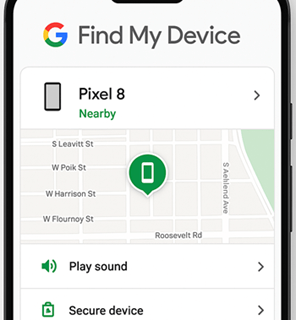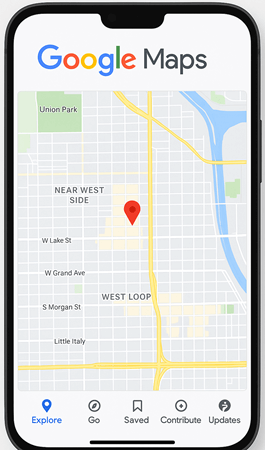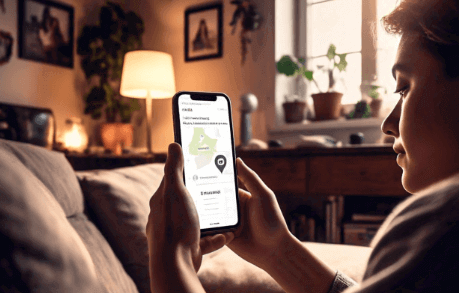Trace Mobile Number Current Location Through Satellite: 5 Ways

Satellite-based mobile number tracking enables real-time location detection using satellite signals. It helps parents monitor children’s safety during travel, helping them to confirm their child’s whereabouts and ensure safety. Satellite-based tracking also aids investigators in tracking assets or suspects accurately. I’ve found this technology especially reassuring when keeping tabs on loved ones or coordinating during unpredictable travel scenarios. However, wrong tools and methods can create fatal consequences. Using unreliable tools or methods can lead to incorrect location data and delayed responses. It can also compromise safety and may cause potential legal or ethical violations.
I researched for over 160 hours and tested 20+ methods to figure out the best available options. My guide aims to provide the most reliable methods, providing readers with clear, actionable strategies to track phone numbers via satellite effectively.
Read more…
Spokeo aggregates public data to help users identify unknown callers and their locations. It proves invaluable for cybersecurity analysts monitoring suspicious device behavior and parents verifying who’s messaging their teens.
Methods to Locate a Phone Number by Satellite
Here are the methods that I have tested and found to be reliable to trace a mobile number’s current location through satellite:
Method 1: GPS Tracking via Monitoring Apps
Location Tracing Probability: Very High
1) Spokeo
Spokeo aggregates public data to help users identify unknown callers and their locations. While not a GPS satellite tracker, it proves invaluable for cybersecurity analysts monitoring suspicious device behavior and parents verifying who’s messaging their teens.
Unlimited Geolocating: Yes
Worldwide Coverage: Coverage is Mostly U.S.-focused
Fast Setup: No Complex Installation or Setup Required.
Free Trial: 7-Day Trial for $0.95
It cross-references social media, court records, and geolocation data to offer insights fast and discreetly. Spokeo has a strong user base among HR managers and online sellers who rely on it to validate identities and prevent fraud. One challenge is outdated or incomplete data. To mitigate this, users should cross-check findings with additional tools or request updates through Spokeo‘s customer support for greater reliability.
How to Use Spokeo for Mobile Number Location Tracking
Here are the steps to use Spokeo to trace a mobile number’s current location:
Step 1) Open Spokeo website
Visit the official site of Spokeo and click on “Phone”.
Step 2) Search phone number
In the blank space, enter the specific phone number and click on “Search Now”.
Step 3) Check the search result
Spokeo will collect publicly available data to provide relevant information related to the phone number.
7-Day Trial for $0.95
2) GEOfinder
GEOfinder enables real-time phone geolocation via SMS-based consent, making it a reliable option for GPS tracking. Fleet managers use it to monitor driver routes and reduce fuel costs, while search and rescue teams have used it to locate missing hikers in low-signal zones. It’s also valuable for travelers and field workers needing discreet, on-demand location sharing. A common challenge is that GEOfinder requires user consent via text, which may delay urgent tracking. To mitigate this, teams should pre-authorize tracking during onboarding or briefings to ensure rapid activation when needed.
Unlimited Geolocating: Send Unlimited Requests
Worldwide Coverage: Supports Global Tracking
Fast Setup: No App Required
Free Trial: 1-Day Trial For $1
Steps to use GEOfinder:
Step 1) From the GEOfinder website, enter the phone number in the space provided, and click on “FIND”.
Step 2) GEOfinder will search from different parts of the globe to fetch data.
Step 3) To view the report, you need to pay a subscription fee.
1-Day Trial For $1
Method 2: Taking the help of built-in device solutions
Location Tracing Probability: High
If you don’t want to pay for third-party tools or the results are not satisfactory enough, taking the help of built-in device solutions can be a reliable way to locate a phone number by satellite. With Find My (iPhone) or Google’s Find My Device via Find Hub, parents can ease anxiety by instantly tracking a child’s phone during emergencies. Also, if you’ve lost your phone, these tools help you locate it fast and avoid data theft. I once used Find My to recover my iPhone left in a cab. The real-time location and sound alert worked perfectly.
Sometimes, the location took time to refresh, but keeping Wi-Fi on and enabling location history helped. A strong network and regular sync improve tracking accuracy. You can also try Google Maps as an alternative option.
Method 3: Using Google Maps
Location Tracing Probability: High
Using Google Maps can turn your phone into a satellite-guided safety net. Solo travelers use it to share their live location with family, easing concerns about safety and connectivity. Also, this method can even help search and rescue teams locate lost hikers quickly when every second matters.
I once relied on it in a remote forest where my phone’s GPS helped authorities trace my path after I got disoriented. However, I noticed a significant battery drainage issue. Thankfully, I was carrying a power bank, which saved my phone from turning off.
Method 4: Social Media and Messaging Apps
Location Tracing Probability: Moderate (varies)
If Google Maps does not deliver satisfactory results, you may consider looking through social media and messaging apps. These apps can be helpful for locating a phone number via satellite, though the accuracy is moderate. Parents can reduce panic by using WhatsApp or Snapchat to view their child’s shared live location during emergencies.
Also, if you are in law enforcement, this method can assist in tracking suspects, provided legal access is secured. I once used Facebook Messenger to find my nephew in a festival crowd. It gave a reasonable estimate, though not precise. The location jumped at times, so I asked him to stay put. Combining live sharing with a quick call helped me refine the positioning of my nephew.
Method 5: Sim-based Tracking
Location Tracing Probability: Moderate
This is another method that requires expert intervention, unlike Google Maps or built-in devices. SIM-based tracking is a reliable method for locating phone numbers via satellite. It helps individuals recover misplaced phones quickly, avoiding data loss and expensive replacements. Also, search and rescue coordinators can use it to pinpoint lost hikers’ devices in isolated zones, accelerating response efforts. With expert help via SIM signal triangulation, I was able to retrieve my phone left in a national park within a few hours. However, this method was again not without its faults.
I have experienced delayed results due to weak signals in some remote regions. Hence, I recommend using signal boosters and alternate towers to manage proceedings. Keeping satellite data synced helps prevent such lags in future use.
Alternative Methods: Tracking Without Satellite
Here are some alternative methods to track your mobile number’s current location compared to the above methods:
- Cell Tower Triangulation: Mobile number location can be traced using cell tower triangulation. This process usually provides accurate results in cities and does not require GPS or satellite connectivity.
- Wi-Fi Positioning: Mobile location can be estimated using Wi-Fi signals by matching nearby networks to a location database, especially when GPS is weak or unavailable indoors.
- IMEI-Based Tracking: Mobile number location can be traced using the device’s IMEI number. However, this tracking is applicable provided it’s reported lost and hasn’t been modified in global tracking databases.
- Bluetooth and Other Signals: Mobile location can be traced using Bluetooth signals from nearby devices, like Apple’s Find My network, which helps locate offline iPhones within a short range.
- Handset-Based and Hybrid Systems: Bluetooth-based tracking helps locate mobile devices at short range. Apple’s Find My network uses nearby Apple devices to find lost iPhones, even when offline.
- SS7 / Diameter & HLR-Lookup Exploits: Mobile number location can be traced via SS7 or Diameter networks by querying HLR data. However, this requires privileged access and is often legally restricted.
What Do You Need to Know Before Satellite-Based Mobile Number Tracking?
Satellite-based mobile number tracking requires several key elements. Here are the prerequisites for satellite-based mobile number tracking, listed clearly:
- Satellite Network Access: Use of GPS, GLONASS, or similar systems.
- Legal Authorization: Government and telecom regulatory approvals as per the local/regional laws.
- Mobile Operator Cooperation: Access to mobile network data (IMSI, signal strength).
- Geolocation Software: Algorithms for triangulation and real-time tracking.
- Specialized Hardware: Ground stations, satellite receivers, and antennas.
- Precise Timing: Synchronized systems using atomic clocks.
- Cybersecurity Measures: Data encryption and access control from reliable providers.
- Skilled Personnel: Experts in satellite, telecom, and data analysis.
Legal considerations when trying to locate a phone number by satellite
When trying to locate a phone number using satellite technology, there are several legal issues to consider. In most cases, tracking a phone’s location, whether through GPS or satellite, requires the informed consent of the person being tracked. However, there are exceptions. For instance, law enforcement agencies may track a phone if they are backed by a valid warrant.
Unauthorized tracking will violate privacy laws and can cause legal consequences such as hefty fines or criminal charges. Additionally, regulations differ by jurisdiction, and international or cross-border tracking introduces further legal complexities and privacy concerns.
Common Issues and Mitigations of Satellite Tracking
Here are some challenges and the mitigation strategies that users may face while trying to trace the current location of a mobile number through satellite:
- Issue: Tall buildings, tunnels, and dense forests can obstruct satellite signals, reducing tracking accuracy.
Mitigation: Use alternative positioning technologies and ensure clear sky visibility. - Issue: Radio frequency interference from other devices or intentional jamming disrupts signals.
Mitigation: Employ frequency-hopping, advanced filtering, and hybrid RF/optical systems. - Issue: Increased satellite numbers raise collision risks and tracking complexity.
Mitigation: Implement better collision avoidance protocols and space traffic management. - Issue: Fewer satellites in view lead to inaccurate positioning.
Mitigation: Use multi-constellation receivers and ensure optimal satellite geometry. - Issue: Weather and ionospheric conditions degrade signal quality.
Mitigation: Apply correction algorithms and real-time atmospheric data.
Cell Tower Triangulation vs. GPS: Which Is More Accurate for Locating a Phone Number?
GPS is significantly more accurate than cell tower triangulation for locating a phone number. GPS typically pinpoints a device within 4–13 feet (about 1–4 meters) under good conditions. In contrast, cell tower triangulation’s accuracy varies widely, ranging from about 50–500 meters in dense urban areas with many towers. However, it is often much less precise in rural areas, sometimes off by miles. Cell tower triangulation only provides a general location, while GPS offers near-exact positioning when satellite signals are available.
FAQs
Conclusion
To sum up, I aimed to give you not just methods but practical insight on tracking phone numbers securely. My experience has shown that solutions like Spokeo work best when paired with up-to-date legal and privacy awareness. I encourage every reader to use these techniques thoughtfully, ensuring that both safety and ethical standards are upheld at every step.
Spokeo aggregates public data to help users identify unknown callers and their locations. It proves invaluable for cybersecurity analysts monitoring suspicious device behavior and parents verifying who’s messaging their teens.










